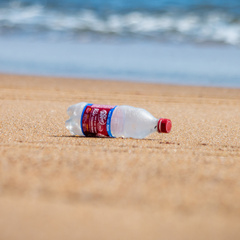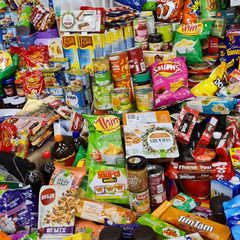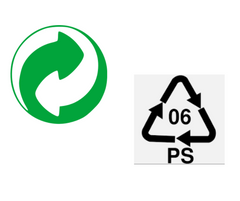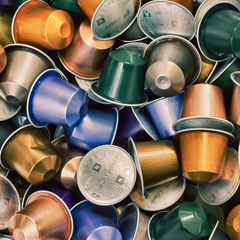Ever since the “Blue Planet” documentary was released, companies are under more pressure to do something about plastic pollution, and we're seeing more and more examples of greenwashing. Investing in measures to protect the environment comes with extra costs. So instead, companies often turn to this form of creative PR spin.
So, what is greenwashing?
Cambridge Dictionary describes greenwashing as "activities that make people believe that a company is doing more to protect the environment than it really is".
Here are 8 greenwashing examples we often see as companies try to fake their green credentials without having to reduce their plastic pollution footprint. In the war on plastic, it's important we learn to spot and stop these greenwashing tactics, so don't forget to tell your friends and family!
#1: "100% Recyclable" plastic bottles
You’ve probably seen plastic bottles labelled “100% recyclable”. This is technically true, but it doesn’t mean they’re eco-friendly. Virtually all plastic bottles are made of PET, which is recyclable. But most of them won't actually be recycled into new plastic bottles. Why? It’s mainly because there’s not enough demand for recycled plastic. For instance, Coca Cola only uses 20% recycled content in their packaging globally. For the recycling loop to work we need 100% recycled plastic bottles, not recyclable. Even then, plastic bottles can only be recycled 2-3 times as the properties of the plastic degrade each time. Not to mention the lack of funding for recycling facilities - with local councils and taxpayers footing most of the bill. It's clear that recycling is definitely not the solution.

Just because it's "100% recyclable", doesn't mean it will get recycled
#2: "Zero-Waste-To-Landfill" is not the same as Zero Waste
Zero-waste-to-landfill sounds like a noble goal for companies, but it’s just another greenwashing example. In the UK, McDonald’s pledged to achieve zero-waste-to-landfill by 2020, and some restaurants even did it sooner. But wait a minute…. their recycling target is only 50% of total waste. What happens to the other 50%? It’s sent to an incineration plant, otherwise known as a “waste-to-energy” plant. Whilst they might sound like a win-win, incineration plants are not zero waste or eco-friendly. Just like burning fossil fuels, burning rubbish emits greenhouse gases. It also leaves toxic “bottom ash”, amounting to around 17% of the incinerated material, which often ends up in landfill anyway.
#3: Zero-Waste Factories That Still Produce Wasteful Products
Companies like Procter & Gamble, Unilever, Nestle and Mars have achieved zero waste-to-landfill at many of their factories (see previous point on that sneaky “to-landfill” greenwashing trick). That would be really great - if those factories weren't pumping out billions of consumer products wrapped in plastic packaging – like toothpaste tubes, deodorant sticks, disposable razors, crisp bags, sweet wrappers, shampoo bottles – mostly destined for landfill.

Snack companies achieve "zero-waste-to-landfill" in their own factories...but still pump out billions of products in non-recyclable packaging!
#4: "Banishing Plastic Packaging Would Cause A Food Waste Crisis!"
In the face of the public backlash on plastic packaging, supermarkets have warned us that if they banish plastic packaging, it will cause a food waste crisis! The facts tell a different story. Between 2004 and 2014 we saw a 40-50% increase in plastic packaging, but there was no corresponding reduction in food waste. In fact, food waste doubled! Myth busted.
Another study by waste charity WRAP in 2022, also found that selling produce in single-use plastic (one of our pet peeves!!) actually increased food waste. They looked at 5 common items - apples, bananas, broccoli, cucumber and potatoes - and estimated that if these items were sold loose, with the best-before dates removed, it could save more than 10,300 tonnes of plastic and about 100,000 tonnes of food waste each year!
#5: Misleading Plastics Recycling Symbols
You've probably seen symbols like the ones below on your packaging and thought "great, it's recyclable!". Think again!
The "Green Dot" symbol simply means that the company has made a financial contribution towards recycling efforts. We're all for producers paying for recycling costs, but using this "green dot" on the actual packaging causes confusion and can contaminate recyclable material with non-recyclable packaging.
Resin classification codes - the triangle with the chasing arrows - also give us the impression packaging is recyclable. The truth is, this code is only describing the type of plastic - like PET, HDPE, LDPE etc. The example below, Polystyrene or "PS", is actually not recyclable. But that doesn't stop companies using these labels on packaging to make us feel like we're buying "green".

The "Green Dot" and Resin classification triangle do NOT mean packaging can be recycled
#6: Coffee Pod Recycling Schemes
Every day, 55 million coffee pods end up in landfill, as they’re too small for conventional recycling facilities, and can take up to 500 years to break down. To handle the criticism, Nespresso introduced a special recycling scheme for their aluminium pods. But do people who don’t want to spend a minute making coffee, bother to collect a bag of 200 empty pods and take them to a drop-off point? Well it turns out they don’t - only 21% of pods are actually recycled. It’s another greenwashing example that allows Nespresso to satisfy eco-friendly customers while continuing on producing masses of single use items.

Every day, 55 million coffee pods end up in landfill
#7: “Recycling” Fast Fashion
As the second most polluting industry, fast fashion is under pressure to reduce waste. High street brands have launched “clothes donation” schemes, offering vouchers for clothes collected to be recycled. During their launch week, H&M collected 1,000 tonnes of clothes. That amount of clothing would take 12 years to recycle…. and is produced by H&M in 48 hours! There’s no way recycling can keep up with the mad pace of fast fashion, and vouchers are a greenwashing tactic that only serve to fuel this overconsumption. Forget recycling clothes - ditch fast fashion altogether and switch to buying second hand clothes online.
#8: Biodegradable, Degradable, Compostable?
Most people assume bioplastics will naturally decompose if thrown out, but that’s hardly ever true. Most compostable plastics, for example, need to be sent to an industrial composting facility. Coca Cola’s PlantBottle is chemically identical to plastic PET bottles, and would need to be recycled with other PET bottles. The confusion often means consumers incorrectly dispose of bioplastics, and they end up in landfills. Bioplastics also help perpetuate the disposable culture that caused the problem in the first place.
Have you spotted any examples of greenwashing that need to be called out? Tell us in the comments below!
Sources
-
https://www.straight.com/news/421761/david-suzuki-problems-incinerating-waste
-
https://friendsoftheearth.uk/plastics/plastic-packaging-failing-prevent-food-waste-crisis-new-study
-
https://www.1millionwomen.com.au/blog/recycling-your-coffee-pods-nespresso-recycling-scheme-working/
-
https://www.huffingtonpost.co.uk/entry/how-sustainable-is-your-coffee-pod-habit_uk_5a61fa1fe4b074ce7a0793a9
-
https://www.theguardian.com/commentisfree/2016/apr/03/rana-plaza-campaign-handm-recycling
-
https://www.theguardian.com/business-to-business/2017/oct/31/the-plastics-problem-are-natural-alternatives-doing-more-harm-than-good

@Jill, Thanks for commenting! I’m always in 2 minds about materials made of single-use plastic. I guess it can work as an interim solution in places where there’s not recycling infrastructure but, as you say, avoiding single-use plastic altogether is the end game.